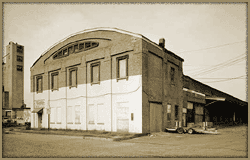







 |
 |
 |
 |
 |
| |
Do we know where all the Underground Railroad routes and stations were?
Many of the routes and stations have remained a secret until this day. When enslaved people were escaping via the Underground Railroad, it was very important to keep these a secret. Although William Still wrote about many places in Pennsylvania, he did not usually name stations or conductors in Maryland because it was too dangerous. Sometimes enslaved people were on their own until they reached Pennsylvania or Delaware. Sometimes conductors from those places traveled south to lead fugitives to safety. Still never says where they met to protect the people and places.

Frederick Douglass left from President Street Station in Baltimore when he began his journey North.
|
Historians are working very hard to discover the exact locations of stations and routes in Maryland. We do know that Frederick Douglass left from the President Street Station in Baltimore when he began his successful train trip north. We know that Harriet Tubman and Samuel Burris traveled from Pennsylvania or Delaware to lead groups out of Maryland. Many groups walked through the fields and woods, hiding in the day time, never stopping at any house until they reached Delaware or Pennsylvania.
We know that free blacks and even some enslaved people hid fugitives in their houses. Many advertisements for the escaped noted that they might be found at the home of relatives in Baltimore. Free blacks operated churches and schools. These too might have been hiding places or stations. Many Quakers lived in Maryland. It is likely that some Quakers and other white people who hated slavery hid fugitives in their homes, churches, and businesses.
Because the Underground Railroad did such a good job, and because the conductors were real heroes, many modern people hope that a tunnel or a trap door in their home or other building means that it was a station. Sometimes those tunnels turn out to have been made for gas and electric lines or for some other purpose that had nothing to do with the Underground Railroad. Historians are like detectives. They want to be sure that information is true and accurate, so they don't list every place with a tunnel or trap door and claim that it was an Underground Railroad Station. They have to find real solid evidence first.
Check back at this site for further information. The site will be updated when historians find any new evidence about Underground Railroad stations and routes in Maryland.
If it was such a secret, how do we know about it today?
« back to About home
|
|
 |
 |
 |
|
 |
|










